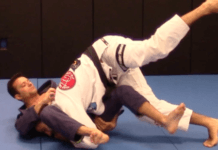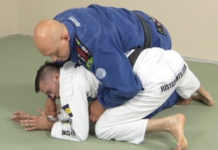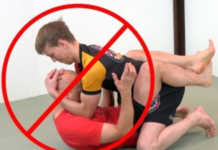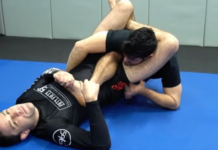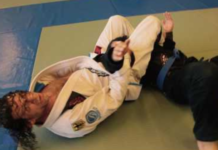There are a few important fundamental moves that you have to learn in BJJ if you wish to get good at it. Depending on your natural predispositions, your previous knowledge, and your dedication – it may take anywhere from a single year to multiple years before you reach a degree of master in these moves. One of the most famous and fundamental moves in BJJ is the so-called guillotine. If you know your history, then you know that the guillotine was a contraption used mostly during the French revolution for the purpose of beheading the enemies of the revolution. Well, the guillotine choke is inspired by this contraption and is used to constrict the blood flow to your opponent’s brain and make them sleep. There are a few variations of the move, and the most important one is the so-called Marcelotine.
Standard Guillotine
Now, how do you perform the regular guillotine? It can be done from various positions, including while the two of you are standing up. But in BJJ matches it’s most common to see this move performed from the closed guard. What you need to do if you’re in the bottom guard position is to throw one of your arms over your opponent’s head, and clasp your wrist with your other hand. The “knife” of the forearm area should be placed directly underneath your opponent’s throat. Then you should use both hands to pull your opponent’s head toward you while at the same time you’re extending your legs. If you wish to visualize it, make the picture in your head of popping a champagne bottle – this is exactly what you will aim to do with your opponent’s head. Of course, this is a potentially dangerous and highly effective move, so make sure that you give your opponent the chance to tap out before popping their head off.
Marcelotine
One of the most famous variations of this move is the aforementioned Marcelotine. The move is named after one of the greatest living BJJ legends, Marcelo Garcia – as he is credited with the invention of the move. This move too can be made from various positions, but it’s most often made from the closed guard or from the butterfly guard. The way Marcelo does it is that he throws his arm over his opponent’s head, much like for the original guillotine, but then he makes sure that he places the bony part near the wrist below his opponent’s throat – he doesn’t put the meaty, muscular part of his arm there. He then grabs his hand with the opposite hand, and he places the elbow of this opposite hand over his opponent’s trapezius muscle. If you have envisioned this move in your head, then you can clearly see that the arms of the person performing the Marcelotine are now formed into a V shape. And now the person doing the Marcelotine doesn’t extend his legs, but on the contrary – he pulls them back. This puts even further pressure on the opponent’s throat, and will likely result in a tap out.
Marcelotine vs. Guillotine
One big difference between the two moves is that the original guillotine can be prevented by passing the guard. This will neutralize it, and even worse for the person doing it, it may lead up to a Von Flue choke if the person still clings to the failed guillotine. But in the case of the Marcelotine, the fact that the elbows are formed into a V shape and are placed over the opponent’s trap muscles. There is little chance of the opponent passing the guard and evading the Marcelotine. But even if the opponent passes the guard – this will make the choke even tighter.
But in the end, both moves are legit. Make sure that you try them out on the mats – perhaps you will find out that one of them suits you better, and that it’s a lot more effective for you to use it.


